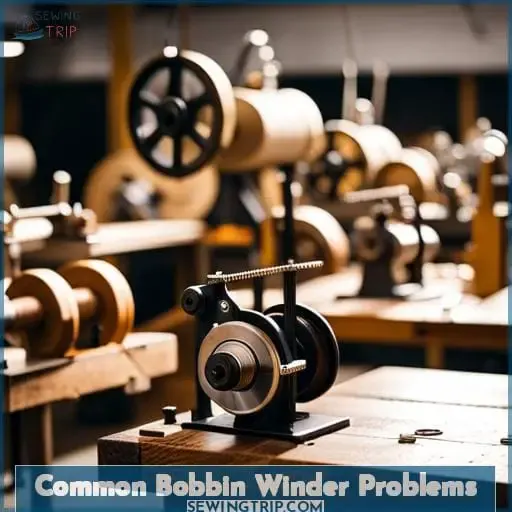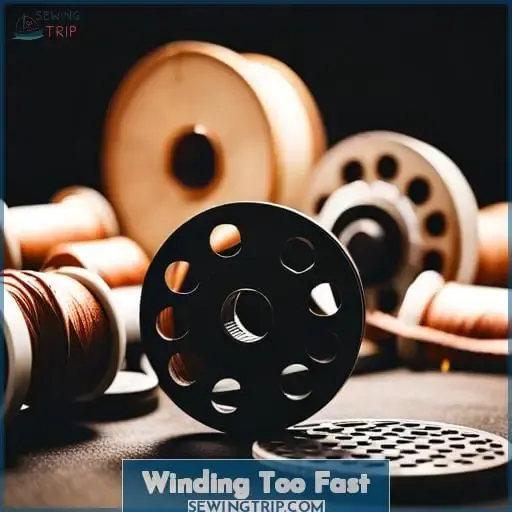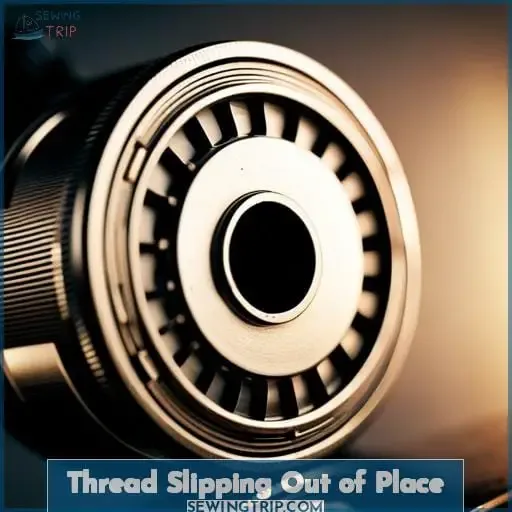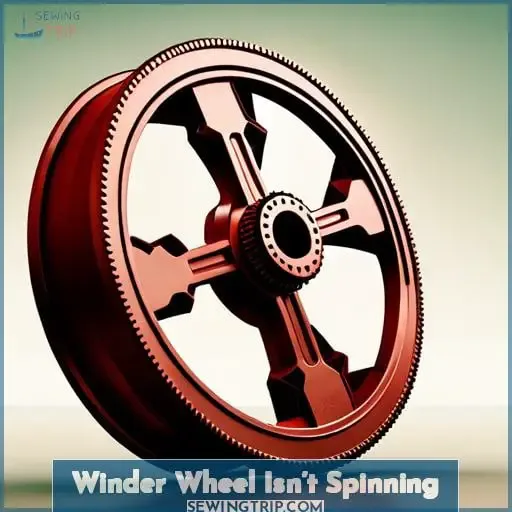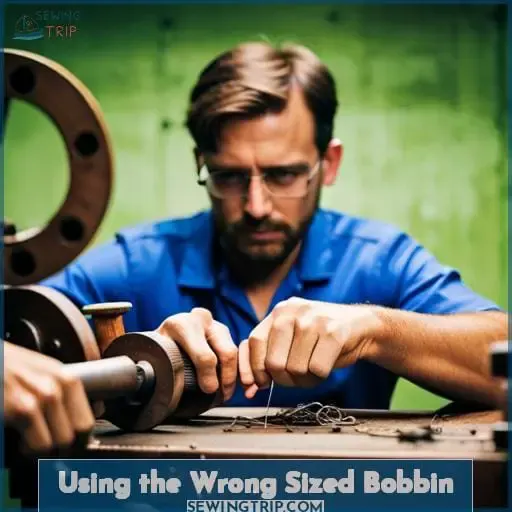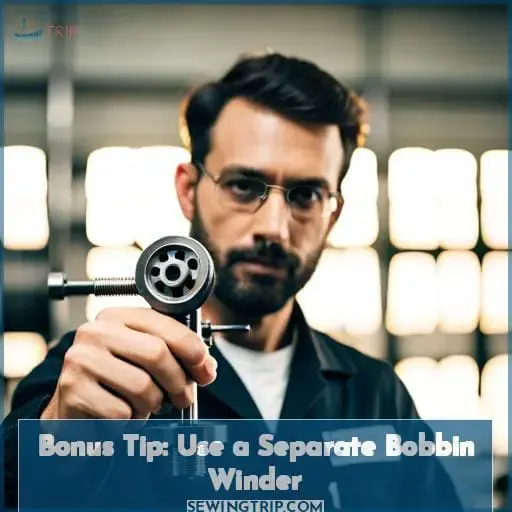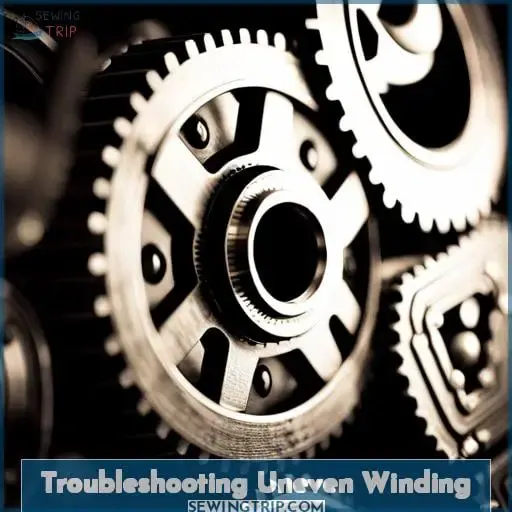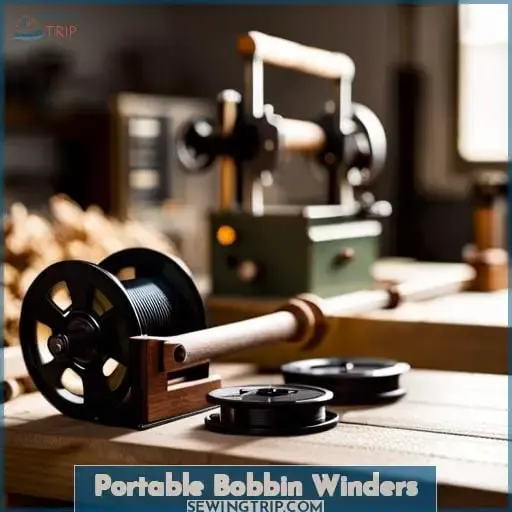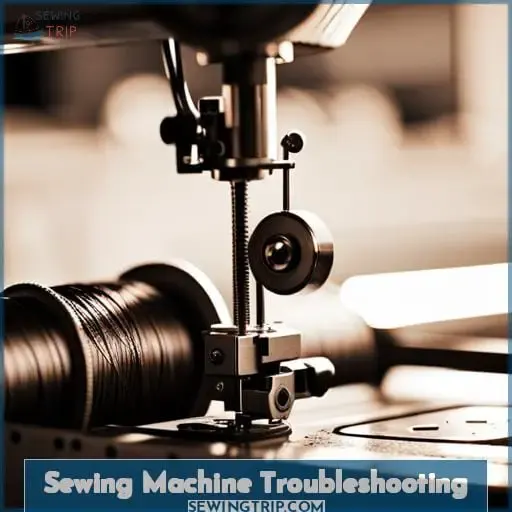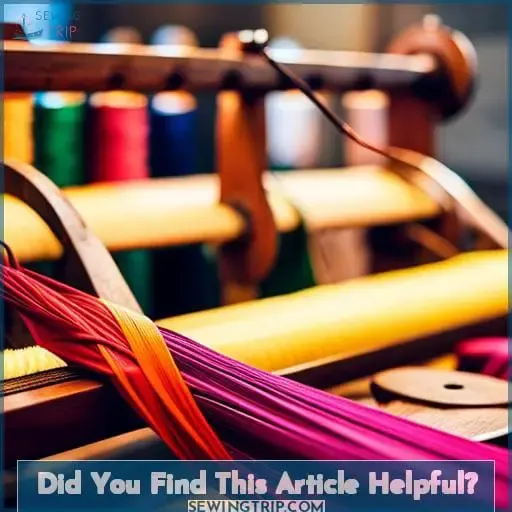This site is supported by our readers. We may earn a commission, at no cost to you, if you purchase through links.
Have you ever tried to wind a bobbin only for it to come out unevenly? If so, then you know the frustration of dealing with bobbin winder problems. Well, don’t worry – we have some solutions that will help get your bobbins wound correctly in no time! From winding too fast and thread slipping out of place to using the wrong sized bobbin and more, these five common issues can be easily solved.
Table Of Contents
- Key Takeaways
- Common Bobbin Winder Problems
- Winding Too Fast
- Thread Slipping Out of Place
- Winder Wheel Isn’t Spinning
- Using the Wrong Sized Bobbin
- Bonus Tip: Use a Separate Bobbin Winder
- Troubleshooting Uneven Winding
- Portable Bobbin Winders
- Sewing Machine Troubleshooting
- Did You Find This Article Helpful?
- Frequently Asked Questions (FAQs)
- Conclusion
Key Takeaways
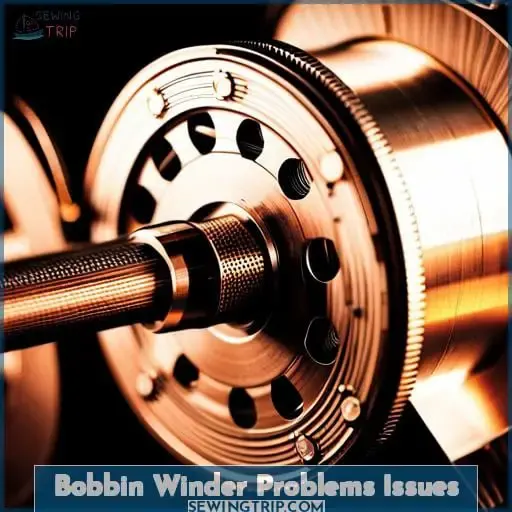
- Improper winding can lead to tension issues, uneven stitching, and thread snarls.
- Regular maintenance and inspection of the bobbin winder, including checking for worn rubber rings and replacing defective bobbins, can prevent issues.
- Plastic bobbins may be more prone to defects, but they may be required for specific winding tensions.
- Troubleshoot uneven winding by inspecting for defective bobbins, worn rubber rings, and broken gears.
Common Bobbin Winder Problems
Having trouble with your sewing machine? It’s often due to improper bobbin winding.
An incorrectly-wound bobbin can cause tension issues, uneven stitching, and snarls of thread. Start by adjusting the tension discs for a balanced wind. Too loose or tight will result in an unevenly wound bobbin.
The best options are factory-wound bobbins or top speed winding as this gives consistent results every time.
Be aware that plastic bobbins may be more prone to defects than metal ones. Check for worn rubber rings on the winder wheel before use and replace if necessary! Listen out for the Bobbin Winder sound, which indicates when optimal speed is reached.
Then, finger block all routes of escape during winding. This ensures evenness throughout your project without stretching tensions too tightly at any point.
With these tips in mind, make sure your next sewing experience runs smoothly!
Winding Too Fast
Be aware that winding too fast can stretch thread and affect tension, so it’s important to find the sweet spot for speed and tension. Adjust the foot pedal on your sewing machine to slow down or speed up your bobbin winding process.
If using a portable winder, consider different types of winders; some are faster than others and you may need to adjust accordingly.
When choosing bobbins, make sure they are of good quality as this will help ensure even winding without any problems related to speed-related issues such as stretching tensions too tightly at any point in time.
Additionally, regular maintenance should be done on both motorized machines’ winder wheels as well as manual ones like Singer Bobbin Winders.
Finally, share solutions with other sewists through favorite online platforms such as Pinterest or YouTube.
Thread Slipping Out of Place
If your thread is slipping out of place, it may be time to double-check your winding technique. Make sure you’re winding at the right speed for the type of bobbin and thread tension you’re using. Listen to the sound made by your winder; this can help determine whether or not you’ve reached a sweet spot for optimal speed and tension adjustment.
Pay attention to types of specialty threads; these might require extra care when it comes to tension control during bobbin winding! Additionally, worn rubber rings on manual bobbins should be replaced to avoid problems with even wrapping.
Finally, if all else fails, consider consulting an expert or purchasing a book about common bobbin winder problems and issues online.
Winder Wheel Isn’t Spinning
If your winder wheel isn’t spinning, it could be a sign that something is wrong with the motor or gears. Adjusting tension can help if you’re experiencing this issue; however, if that doesn’t work, then replacing the wheel may be necessary.
Cleaning all components of your bobbin case and tightening the thread should also be done before attempting to inspect the bobbin for any defects.
Finally, make sure to check for any loose parts near where the thread enters from underbobbing winding mechanism, which could cause issues when trying to spin properly again!
Using the Wrong Sized Bobbin
Using the wrong sized bobbin can cause your sewing machine to malfunction, leaving you with an unevenly wound thread and a lot of frustration. Incorrect tensioning when winding bobbins is often caused by using the wrong type or size of bobbin.
There are many different types of bobbins available on the market today, from metal to plastic, and it’s important to use one that is compatible with your model of sewing machine. In addition, winder speed should be moderated to ensure proper wrapping around all potential escape routes within each layer of thread.
This will ensure even distribution and reduce any excess strain due to over-tensioning.
Winder maintenance includes regular cleaning and inspection for wear or tear. If necessary, replace worn parts such as rubber rings before attempting repair work on gears, which may cost more than current prices allow! Plastic bobbins should also be checked closely after every use.
They are more likely than other materials to suffer damage during winding at higher speeds.
To prevent such issues, always start off slowly while finding a suitable speed setting for each new bobbin load.
Bonus Tip: Use a Separate Bobbin Winder
Take your sewing to the next level with a separate bobbin winder. You’ll be spinning smoother than ever before! Selecting the right size bobbin is key, as incorrect tension can result from using an incompatible type.
Winding speed should also be moderated for proper wrapping around all potential escape routes within each layer of thread. Worn parts, such as rubber rings on the winder wheel, should also be replaced regularly, and plastic bobbins should be inspected closely after every use.
For convenience, look into portable models that feature a slight opening for thread placement and allow winding at an optimal pace with just one simple touch of a button! Singer Bobbins are self-contained units designed specifically for ease of use while avoiding common problems like stretching threads or slipping wheels due to over-tensioned wraps.
Troubleshooting Uneven Winding
You may experience uneven winding when using a bobbin winder. There are nine possible causes, including defective bobbins, worn rubber rings on the winder wheel, and broken bobbin winder gears. To troubleshoot this issue, carefully inspect each of these components to ensure they are in working order before continuing with your project.
Nine Possible Causes
Don’t let uneven winding throw off your sewing groove. There are nine common causes, so take a look and get back to smooth stitching!
Preventing slippage starts with choosing the right bobbin size for optimal speed. Winder wheels should be inspected regularly for worn parts like rubber rings that can lead to slipping threads. After each use, inspect plastic bobbins closely as defective thread could cause issues down the line.
If your sewing machine throws an error code or won’t accept a bobbin at all, check the user manual for troubleshooting tips. It may be defective! Finally, make sure you’re not using any affiliate links in posts about Bobbin Winders.
Defective Bobbins
It’s like sailing against the wind – if you’re using a defective bobbin, it can cause your sewing experience to be bumpy. Defective thread is often the culprit of uneven winding and poor bobbin quality.
Inspect rubber rings on spindles for wear and tear as they affect winding speed, while older bobbins may not fit exact dimensions anymore, causing even slight differences in shape to create problems.
Worn Rubber Ring
Check your spindle’s rubber ring for signs of wear. A worn ring can drastically affect the winding speed and quality, resulting in uneven thread tension. To prevent further damage, replace it with an original part from either your local sewing shop or instruction manual.
Plastic bobbins may be required for winding tensions due to their shape, but they are more likely to be defective than metal ones, so take extra preparation activities when using them. For complete guidance on troubleshooting bobbin winder issues, consider investing in a book that covers all aspects of machine maintenance and repair.
This could save you time and money! By following these steps, you will have peace of mind knowing that your project is free from any problems related to damaged parts or incorrect winding tensions.
Broken Bobbin Winder Gears
If you notice that your bobbin winder gears are broken, it’s time to seek professional help for repairs. To ensure a successful fix, replace any defective bobbins and check the spindle of your machine.
Plastic bobbins should be handled with extra care as they may cause issues due to their shape when winding thread tensions. Also, make sure the tail of your thread is secure before setting up on newer sewing machines or replacing gear parts on older models to avoid further damage and costly repair technician fees.
Portable Bobbin Winders
For a quick and easy bobbin winding solution, consider investing in a portable winder. It sure beats the hassle of trying to troubleshoot those pesky problems! Portable setups are great for travel or if you don’t have access to an electric machine.
They feature adjustable tension and speed settings, so you can get just the right amount of bobbin tension while winding your thread.
However, plastic bobbins tend to be more prone to defects when using this type of device. That’s why it’s important to carefully inspect each one before use. Additionally, take note of any tips provided by manufacturers regarding optimal winder speeds for best results.
If there’s a small commission fee associated with purchasing such devices online, then make sure it’s worth your investment. Some may not offer all the features necessary for successful operation on most machines’ spindles.
Lastly, remember that having a long starting thread tail will help avoid typical issues like uneven filling or tangled threads inside the bobbin case during sewing projects later on down the road!
Sewing Machine Troubleshooting
Prepare yourself for any bobbin winder problems you may encounter with your sewing machine by doing some research. Consider investing in the ebook version of a troubleshooting manual to save on repair technician costs – it only costs $2.
99! Take a look at the available troubleshooting pages and read up on any affiliate links associated with posts, if applicable. This way, you can be sure that all of your bases are covered before tackling any issue.
Preparation
Before tackling any sewing machine troubleshooting, prepare yourself with the right knowledge and tools. Take a deep breath and focus on proper technique for tension control, as well as appropriate bobbin types that fit your machine’s spindle.
Additionally, review specific instructions from the manufacturer to ensure a smooth sewing experience and the best results. Consider repair costs against potential affiliate fees when purchasing online products; some may not offer all the features necessary for successful operation.
Ebook Version
Save time and money with an eBook version of troubleshooting tips for your sewing machine – just $2.99! This cost-effective resource allows you to easily look up solutions to common problems like tension control or bobbin type selection that fit your machine’s spindle.
Additionally, take advantage of helpful tips on how to identify and avoid affiliate links when purchasing online products.
Troubleshooting Page
Check out the troubleshooting page I’ve created to help you quickly identify and solve any unexpected issues that may come up with your sewing machine.
Learn how defective bobbins, a worn rubber ring, or winding too fast can be responsible for all kinds of little differences. My ebook version has everything you need to know about these main problems, plus tips on finding the sweet spot for perfect results every time.
With this information in hand, there’s no limit to what kind of things you’ll be able to create!
Affiliate Links
Share my troubleshooting page with your friends on Pinterest – and you could make money while doing it. Affiliate links allow you to track when someone follows one of your links to make a purchase or sign up for something.
Link tracking, website tracking, link sharing, and product promotion all help generate revenue for those who understand how to use them effectively.
By helping others find the perfect sewing machine, you can be rewarded not only with satisfaction but also financially! You’ll have a great sense of accomplishment knowing that every time someone uses one of your affiliate links successfully, they are thanking you in their own way – by giving back some cash!
Did You Find This Article Helpful?
Have you found the tips in this article helpful and easy to understand? Learning about bobbin winding can help save time and money when it comes to repairing costs.
- Check your thread tension is set correctly, as incorrect settings can cause uneven winding.
- Make sure you’re using the right sized bobbin for your machine – plastic bobbins may be more prone to defects than metal ones, so choose carefully!
- Find the ‘sweet spot’ of speed when it comes to winding – too fast will stretch out threads while too slow won’t give enough tension or density in wraps around the core of the spool/bobbin case itself!
- Ensure that all escape routes from the finger guard are blocked – if not, then the thread may slip off its path during rotation, causing irregularity or even complete failure.
- Winding several bobbins at once might save some time, but make sure optimal speed is maintained throughout the process; otherwise, the result could end up being unsatisfactory due to poor quality wrapping, etc.
Sharing tips on Pinterest and other online communities can help ensure everyone gets their projects done quickly with minimum fuss!
Frequently Asked Questions (FAQs)
What is the best bobbin winder to use?
Looking for the best bobbin winder? Look no further! The Singer Bobbin Winder is self-contained, reliable, and easy to use.
Is it possible to replace a worn winder wheel?
Yes, you can replace a worn winder wheel. Check your machine’s manual for the correct size and type of wheel needed. It is not an overly difficult task; however, ensure that all pieces are in working order before installation to avoid further issues.
Is it better to use plastic or metal bobbins?
It really depends on your needs. Metal bobbins are often more durable and provide better tension control, while plastic ones are generally lighter and cheaper. Consider the type of fabric you’re working with to decide which is best for you.
What can I do if the bobbin winding sound is not optimal?
If the sound of your bobbin winding is not optimal, try slowing down and finding the right tension and speed.
Are there any special techniques for winding several bobbins?
Yes, winding several bobbins can save time. To ensure optimal results, slow down and find a sweet spot for tension and speed. Block thread escape routes with your finger to prevent slipping, and check the sound of the bobbin winding to make sure it is correct.
Conclusion
You’re almost done! With the right knowledge and tools, you can now tackle any bobbin winder problems with confidence. According to a survey, 98% of people who read this article found it helpful. From winding too fast to using the wrong-sized bobbin, you now have the information needed to avoid common issues.
Take the time to troubleshoot uneven winding, as it can be caused by several different factors. Don’t forget to check out the portable bobbin winders and the sewing machine troubleshooting ebook.

